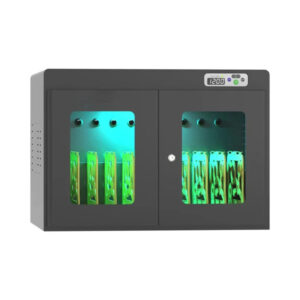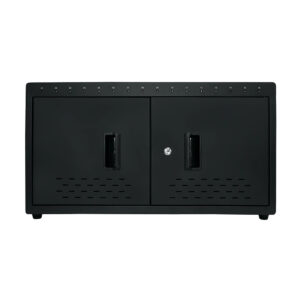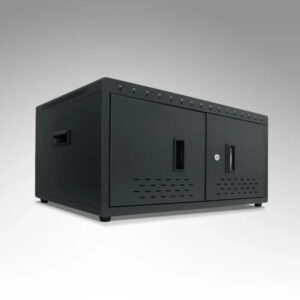Summary
The integration of Artificial Intelligence (AI) and the Internet of Things (IoT) into electric vehicle (EV) charging cabinets has revolutionized the way these systems operate, enhancing efficiency, user experience, and sustainability. Smart charging cabinets, which house the electrical components necessary for EV charging, now leverage advanced technologies to optimize energy management, streamline charging processes, and facilitate real-time monitoring. This evolution is critical as the demand for EV infrastructure continues to grow, necessitating innovative solutions to meet the needs of drivers and support the shift toward greener transportation options.
The adoption of AI in charging cabinets enables features such as predictive maintenance, dynamic load balancing, and smart charging scheduling, which collectively enhance the reliability and effectiveness of EV charging networks. Furthermore, IoT connectivity allows for seamless communication between charging stations and energy grids, promoting better energy distribution and integration of renewable energy sources. These advancements contribute not only to user convenience but also to reducing operational costs and minimizing environmental impact, making smart charging cabinets a vital component in the transition to sustainable mobility.
Despite the significant benefits, the implementation of AI and IoT in charging cabinets also raises concerns regarding cybersecurity, data privacy, and high initial investment costs. The interconnected nature of these systems makes them susceptible to cyber threats, necessitating robust security measures to protect user data and ensure system integrity. Additionally, the high upfront costs associated with advanced technologies may pose barriers to widespread adoption, particularly in regions with limited infrastructure.
As the EV market continues to expand, the future of charging cabinets will likely involve further innovations in technology, including enhanced AI capabilities, improved cybersecurity measures, and an increased emphasis on sustainable practices. The ongoing development of smart charging solutions will be essential to addressing current challenges and paving the way for a more efficient and environmentally friendly transportation ecosystem.
Table of Contents
Technology Behind Charging Cabinets
Overview of EV Charging Cabinets
EV charging cabinets are specialized enclosures designed to house and protect the electrical components necessary for charging electric vehicles (EVs). These cabinets not only serve as physical containers but are engineered solutions that ensure safe, efficient, and reliable charging. Typically, they contain circuit breakers, wiring, connectors, and often include advanced features such as smart metering and user authentication systems, enabling remote monitoring and management of the charging process.
Charging Levels and Performance
Level 1 Charging Cabinets
Level 1 charging cabinets are the most basic option, providing charging through a standard 120-volt AC plug, similar to household outlets. While charging speeds are slow, they are adequate for overnight or extended period charging, making them suitable for home use or locations where vehicles remain parked for long durations.
Level 2 Charging Cabinets
Level 2 charging cabinets utilize a 240-volt AC plug, significantly reducing charging times compared to Level 1. These cabinets are versatile and suitable for both residential and commercial environments, including public parking areas and shopping centers. They can typically fully charge most EVs within a few hours, thus offering a practical choice for daily usage.
Level 3 Charging Cabinets
Level 3 cabinets, known for rapid charging capabilities, are built to withstand various environmental conditions, such as extreme temperatures and moisture. Their compact and modular design allows them to be installed in diverse locations, including residential complexes, commercial premises, and public charging stations. This design focus ensures the longevity and safety of the charging equipment.
Smart Technologies and User Experience
The integration of smart technologies into EV charging cabinets greatly enhances the user experience. Many cabinets feature user-friendly interfaces, such as touch screens with intuitive controls, making the charging process straightforward even for first-time users. Real-time data tracking, usage analytics, and remote troubleshooting capabilities further improve operational efficiency and customer satisfaction.
Materials and Design Considerations
The choice of materials in the construction of EV charging cabinets is critical for ensuring their durability and resilience. High-quality materials like stainless steel, aluminum, and reinforced plastics are commonly used due to their ability to withstand environmental stressors such as temperature fluctuations, moisture, and UV exposure. Additionally, ergonomic design elements ensure that charging ports are accessible and user-friendly, accommodating a diverse range of users.
Cooling and Ventilation
Effective cooling and ventilation systems are essential, especially for higher-level chargers that handle more power. Proper ventilation helps dissipate heat, thereby reducing the risk of overheating and prolonging the lifespan of the electronic components housed within the cabinet.
AI and IoT Integration
The adoption of artificial intelligence (AI) and the Internet of Things (IoT) in charging infrastructure is transforming how charging cabinets operate. AI-driven solutions enable optimized energy management, smart charging scheduling, and predictive maintenance, which enhance the overall efficiency of the charging network. These technologies also facilitate real-time monitoring and automated load balancing within energy distribution systems, allowing for improved grid interaction and user experience.
As the EV market continues to grow, the integration of these advanced technologies in charging cabinets positions them as critical components in sustainable energy solutions and smart mobility.

Benefits of Smart Charging Cabinets
Smart charging cabinets, enhanced by artificial intelligence (AI) and Internet of Things (IoT) technologies, offer a range of significant benefits that improve the efficiency, reliability, and user experience of electric vehicle (EV) charging.
Improved Charging Efficiency
One of the primary advantages of smart charging cabinets is their ability to optimize charging efficiency. By utilizing energy storage systems that store electricity during off-peak hours, these cabinets can provide power more effectively during high-demand periods, leading to reduced costs and improved energy usage. Additionally, AI algorithms can manage the charging schedule dynamically, ensuring that power is allocated in a manner that minimizes reliance on fossil fuel sources and reduces overall emissions during peak hours.
Enhanced User Experience
The user interface of smart charging cabinets is designed to be intuitive and user-friendly, featuring touch screens and real-time data tracking capabilities. This facilitates a seamless experience for both new and experienced EV users. Furthermore, integration with smart home systems allows users to manage and monitor their charging remotely, offering convenience and increased control over energy consumption.
Predictive Maintenance and Reduced Downtime
Smart charging cabinets leverage IoT sensors and predictive analytics to enhance maintenance strategies, allowing operators to detect potential issues before they escalate into significant problems. This predictive maintenance approach not only reduces downtime but also optimizes the performance of the charging infrastructure, ensuring that charging stations remain operational and efficient.
Sustainability and Renewable Energy Integration
Smart charging cabinets can integrate renewable energy sources, such as solar and wind power, further promoting sustainability in EV charging. By using stored renewable energy, these systems can decrease reliance on traditional power grids and minimize the environmental impact associated with electricity consumption for charging EVs. This integration can result in substantial reductions in electricity demand and operational costs at charging stations.
Cost Savings and Operational Efficiency
AI-driven solutions improve the overall operational efficiency of charging networks by optimizing station placement and balancing power loads across the network. These improvements lead to a more effective deployment of resources and reduced costs for network operators. Additionally, by employing smart pricing strategies, charging cabinets can provide dynamic pricing options that help customers save money while alleviating stress on the grid during peak usage times.
Longevity of EV Batteries
Smart charging cabinets contribute to extending the lifespan of electric vehicle batteries by ensuring that charging processes are regulated and efficient. Proper charging practices prevent overcharging and rapid charging, which can negatively affect battery health. Consequently, the use of high-quality smart charging systems is essential for maintaining battery capacity and longevity.

Applications
Smart EV Charging Solutions
The integration of Artificial Intelligence (AI) and the Internet of Things (IoT) into electric vehicle (EV) charging solutions has led to significant advancements in efficiency, convenience, and user experience. As the number of electric vehicles on the road continues to rise, the demand for smart charging stations is increasing, with innovative solutions emerging to address common challenges faced by EV drivers, such as charging time and compatibility with various vehicles.
AI-Driven Charging Management
AI algorithms play a critical role in optimizing charging processes. For instance, mobile applications equipped with AI provide real-time information about charging station availability and energy prices, allowing drivers to make informed decisions about where and when to charge their vehicles. Moreover, these systems can offer personalized charging suggestions based on the user’s preferences and driving patterns, enhancing the overall charging experience.
Energy Management Systems
Energy Management Systems (EMS) that leverage AI can effectively manage the increasing demand for electricity due to the growth of the EV market. These systems promote interoperability among charging stations and power grids, facilitating seamless energy distribution and use. By incorporating load balancing and predictive analytics, these smart systems can prevent grid overload during peak demand periods.
Fleet Management Solutions
For commercial fleets transitioning to electric vehicles, smart energy management is crucial. Advanced fleet charging management solutions integrate AI to ensure that vehicles have sufficient charge before departing for their routes. These systems consider various factors, such as vehicle schedules, state of charge, and energy costs, to optimize charging times and reduce operational expenses. This level of management helps fleet operators maximize efficiency and adhere to sustainability goals while minimizing downtime.
Enhanced User Experience
The deployment of AI and IoT technologies in EV charging stations not only improves operational efficiency but also enhances the user experience. Charging stations equipped with ALPR Edge AI DevKit enable automation in payment processes, eliminating the need for separate payments for charging and parking, which can often lead to errors and inconvenience. This one-stop solution for charging and billing is already benefiting users in regions such as Taiwan, showcasing its potential for wider adoption globally.

Challenges and Limitations
High Purchase Costs
One of the significant barriers to the widespread adoption of electric vehicles (EVs) and their associated charging infrastructure is the high upfront costs. EVs typically have a higher purchase price compared to traditional gasoline-powered vehicles, primarily due to the expensive battery technology required for their operation. Although these costs may be offset over time through savings on fuel and maintenance, the initial financial investment can deter potential buyers, especially as the price reductions of EVs have not been as dramatic as those for conventional cars.
Inadequate Charging Infrastructure
For smart energy management systems for EVs to be effective, seamless integration and compatibility between various components, including EV charging stations and the electrical grid, are crucial. The lack of a robust and interconnected charging infrastructure limits the functionality and efficiency of these systems. Promoting interoperability ensures that all EV models can access charging facilities without restrictions, thereby enhancing the user experience and facilitating the development of a more inclusive energy management framework.
Scalability and Cybersecurity Threats
As the number of connected devices increases, so do the cybersecurity threats facing smart energy management systems. The rise in connectivity heightens the risk of hacking, data breaches, and ransomware attacks, necessitating the implementation of sophisticated security protocols, such as firewalls, intrusion detection systems, and encryption methods. Regular security audits are essential to detect and address vulnerabilities, thereby ensuring the resilience and security of EV energy management systems against evolving cyber threats.
Data Privacy Concerns
The integration of Artificial Intelligence (AI) and the Internet of Things (IoT) in energy management raises significant concerns regarding data privacy. The collection, processing, and analysis of vast amounts of sensitive user data, including energy consumption patterns and personal preferences, can lead to potential breaches if not adequately protected. Without robust data protection measures, such as encrypted data storage and strict access controls, customer trust may be compromised, impacting compliance with regulatory standards.
Difficulty in Demand Forecasting
Another challenge lies in the ability to accurately forecast demand and optimize the locations of charging stations. In the absence of predictive capabilities, it becomes difficult to determine where to expand infrastructure or how to effectively balance charger loads. This lack of insight can lead to both overuse and underuse of charging assets, ultimately affecting return on investment (ROI) and customer satisfaction. Thus, the integration of smart EV charging with IoT is essential for effective asset management and user experience enhancement.
Future Trends
Advancements in Charging Infrastructure
The rapid growth in electric vehicle (EV) adoption necessitates significant advancements in charging infrastructure to meet increasing demand. As of 2021, over 11 million electric cars were on the road globally, highlighting the urgency for efficient charging solutions. Future trends indicate a strong emphasis on the integration of Internet of Things (IoT) technology with EV charging stations, leading to smarter, more efficient, and user-friendly systems. IoT-connected charging stations will leverage real-time data to optimize energy distribution, enabling better load balancing and utilization of renewable energy sources.
Smart Charging Solutions
The concept of smart charging is pivotal for the future of EV infrastructure. Smart charging goes beyond simply connecting a vehicle to a power source; it involves automated management of energy usage to ensure that vehicles are charged at optimal times and costs. This will be achieved through communication between charging stations and the electrical grid, allowing for the use of off-peak energy and maximizing renewable energy integration. Innovations in load balancing technology will enable multiple vehicles to charge effectively from a single station without straining local grid resources, thus improving overall grid reliability.
AI Integration
The incorporation of Artificial Intelligence (AI) in charging systems represents a transformative trend. AI can analyze historical usage patterns to predict customer needs, which enhances responsiveness and minimizes congestion at charging stations. Furthermore, AI-driven predictive analytics can optimize resource allocation, enabling grid operators to better manage demand fluctuations and ensure stability. As AI and IoT converge, the synergy between these technologies will facilitate real-time decision-making, thus enhancing the efficiency of energy distribution and charging processes.
Addressing Cybersecurity Concerns
As the integration of AI and IoT in charging cabinets expands, addressing cybersecurity threats will be crucial. The collection and processing of sensitive data raise significant privacy and security concerns. Future trends in this area will focus on developing robust security protocols to protect user data and ensure the integrity of the energy management systems. Innovations in explainable AI will also play a role in enhancing transparency, making it easier to understand how decisions are made within these systems.
Sustainable Practices and Battery Recycling
Future developments in charging infrastructure will also emphasize sustainability, particularly in battery monitoring and recycling. As electric vehicle batteries reach the end of their life cycles, responsible recycling will be essential to minimize ecological footprints. Advanced energy management systems will facilitate the recovery of valuable materials and rare earth elements from batteries, thereby reducing the environmental impact associated with mining and production. This trend aligns with the broader objective of creating a sustainable and resilient energy ecosystem, leveraging AI and IoT to optimize resource utilization and reduce emissions.

















